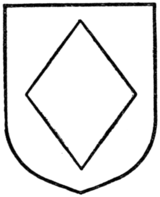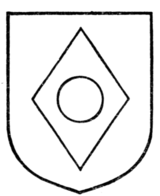ordinaries tinctured "lozengy of two colours." The arms of Bolding are an example of a bend lozengy.
The fusil is supposed to be, and is generally depicted, of a greater height and less width than a lozenge, being an altogether narrower figure (Fig. 231). Though this distinction is generally observed, it is not always easy to decide which figure any emblazonment is intended to represent, unless the blazon of the arms in question is known. In many cases the variations of different coats of arms, to suit or to fit the varying shapes of shields, have resulted in the use of lozenges and fusils indifferently. Fusils occur in the historic arms of Daubeney, from which family Daubeney of Cote, near Bristol, is descended, being one of the few families who have an undoubted male descent from a companion of William the Conqueror. In the ordinary way five or more lozenges in fess would be fusils, as in the arms of Percy, Duke of Northumberland, who bears in the first quarter: Azure, five fusils conjoined in fess or. The charges in the arms of Montagu, though only three in number, are always termed fusils. But obviously in early times there could have been no distinction between the lozenge and the fusil.
 Fig. 230.—Lozenge. |
 Fig. 231.—Fusil. |
 Fig. 232.—Mascle. |
 Fig. 233.—Rustre. |
The mascle is a lozenge voided, i.e. only the outer framework is left, the inner portion being removed (Fig. 232). Mascles have no particular or special meaning, but are frequently to be met with.
The blazon of the arms of De Quincy in Charles's Roll is: "De goules poudré a fause losengez dor," and in another Roll (MS. Brit. Mus. 29,796) the arms are described: "De gules a set fauses lozenges de or" (Fig. 234). The great Seiher de Quincy, Earl of Winchester, father of Roger, bore quite different arms (Fig. 235). In 1472 Louis de Bruges, Lord of Gruthuyse, was created Earl of Winchester, having no relation to the De Quincy line. The arms of De Bruges, or rather of Gruthuyse, were very different, yet nevertheless, we find upon the Patent Roll (12 Edward IV. pt. 1, m. 11) a grant of the following arms: "Azure, dix mascles d'Or, enormé d'une canton de nostre propre Armes de Angleterre; cest a savoir de Gules a une Lipard passant d'Or, armée
